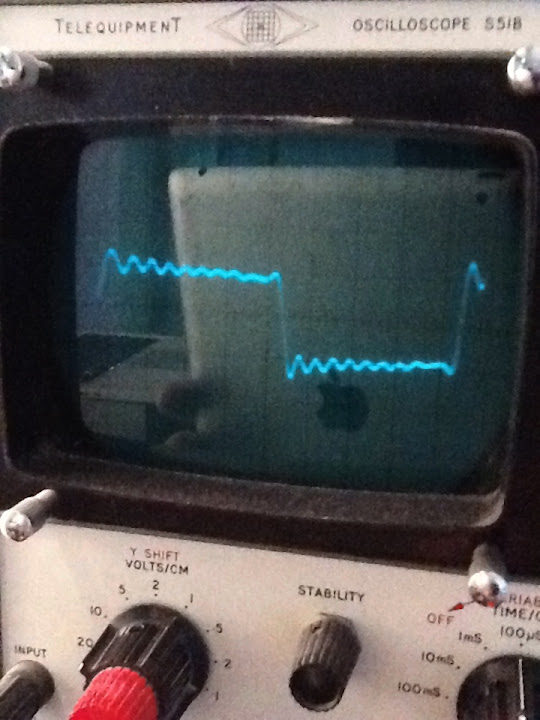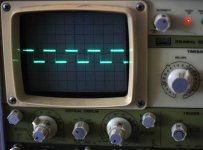I connected an macbook pro minijack out to my tube amp under test and got this ringing response on the scope when feeding it a 1k Hz tone from a software signal generator. This is the signal from the mac on the input. Not the output from the amp. Any ideas why?


Last edited:
To me it looks like impedance mismatch. Connect the sound card output to the circuit using a piece of coax cable. Between the sound card output and the coax center conductor should be a resistor with a resistance equal to the characteristic impedance of the coax. On the output of the coax (from center conductor to ground - across amp input) should be another resistor of the same resistance. If it still rings under those conditions, I'd blame the sound card or software.
Audio frequencies don't normally require transmission lines in order to preserve signal fidelity. But square waves contain a lot of harmonics - in fact, in theory, an infinite number of them. Hence, a square wave is a high-bandwidth signal and should be treated as such.
~Tom
Audio frequencies don't normally require transmission lines in order to preserve signal fidelity. But square waves contain a lot of harmonics - in fact, in theory, an infinite number of them. Hence, a square wave is a high-bandwidth signal and should be treated as such.
~Tom
imix500, I tried running on batteries and also tried another tone generator, and played with amplification. No difference unfortunately.
tomchr, I am using an ordinary cheap, mini jack to phono/RCA plugs cable. I´ll try your ideas later tonight, when the good wife has had some company. I have 75ohm antenna coax somewhere, would I use 75 ohm resistors, then?
I also worry that the problem may be with the olde tube scope. I am using a new 1x/10x coax probe, though.
tomchr, I am using an ordinary cheap, mini jack to phono/RCA plugs cable. I´ll try your ideas later tonight, when the good wife has had some company. I have 75ohm antenna coax somewhere, would I use 75 ohm resistors, then?
I also worry that the problem may be with the olde tube scope. I am using a new 1x/10x coax probe, though.
I don´t have an external dac -yet
Make's a big difference. I use an Edirol FA66 on my music server (iMac G5)
dave
If you want good square waves, build or buy a square wave generator. It's pretty easy to get right, so even cheap ones can work well. You could do it better than you are now digitally with a 192kHz sample rate and some digital filtering, but still well short of about a dollar's worth of parts and a couple of batteries.
A function generator is a good investment. Sine waves are high distortion, but perfect useful for getting power measurements, triangle and square waves are of excellent quality in surplus units or inexpensive kits.
A function generator is a good investment. Sine waves are high distortion, but perfect useful for getting power measurements, triangle and square waves are of excellent quality in surplus units or inexpensive kits.
I tried removing the cable from the mac book, and instead inserted a mini jack without a cable attached. I measured right at the output from the Mac book. Same ringing square waves. Conclusion : its the mac books onboard dac/amp or the software. (have´nt tried impedance matching yet)
Using ToneGeneratorX playing through Audio Hijack Pro with system audio highjacked I tried a 1kHz square wave and digital filters. The only thing that worked was to low pass at 10kHz, this reduced ringing by approx 50% going any lower made rise time slower and rounded the front corner. Conclusion: The Mac Books onboard electronics or software is not good enough.
Using ToneGeneratorX playing through Audio Hijack Pro with system audio highjacked I tried a 1kHz square wave and digital filters. The only thing that worked was to low pass at 10kHz, this reduced ringing by approx 50% going any lower made rise time slower and rounded the front corner. Conclusion: The Mac Books onboard electronics or software is not good enough.
Hi Trondareo, I had the same problem with My PC with my audigy II ZS soundcard. I created my own square wave generator using a 555 timer IC. I can't locate the schematic I used right at the moment though, I think I have it at home. Total cost was less than $2.00 and as far as I can tell the performance was ok.
Below is a picture of the output on my scope. It was supposed to be 10Khz but was a bit lower due to not having an exact value for the cap.
I think the circuit I used was pretty much the one on this wikipedia page (under astable) I had some trouble getting a duty cycle of 50% and I think I had to add the suggested diode to do so.
edit: here is the site that I got the original circuit from. http://www.electronics-tutorials.ws/waveforms/555_oscillator.html
Tony.
Below is a picture of the output on my scope. It was supposed to be 10Khz but was a bit lower due to not having an exact value for the cap.
I think the circuit I used was pretty much the one on this wikipedia page (under astable) I had some trouble getting a duty cycle of 50% and I think I had to add the suggested diode to do so.
edit: here is the site that I got the original circuit from. http://www.electronics-tutorials.ws/waveforms/555_oscillator.html
Tony.
Attachments
Last edited:
Sinewaves up to 96Khz (with 192Khz sampling) look clean on the scope  so I think that they are ok. I don't have a distortion analyser (other than using fft on the same pc) so I can't vouch for how good they really are, just that they look like sine waves with no gross (ie easily detectable by eye) distortions on the scope
so I think that they are ok. I don't have a distortion analyser (other than using fft on the same pc) so I can't vouch for how good they really are, just that they look like sine waves with no gross (ie easily detectable by eye) distortions on the scope 
Tony.
Tony.
Sorry, I should have been clearer and put in a quote. I was referring to Tom's suggestion that Trondareo's square wave ring looked like an impedance mismatch and that he could try testing it by using properly terminated co-ax. I was interested to know if Trondareo tried it and what the results were.
Sorry for the delay, I have tried impedance matching. Same ringing square wave.
I also tried a minijack to BNC coax alone. Same effect.
In all cases the lead is no more than 1 meter.
I am not familiar with the anti-aliasing that was mentioned.
It would be great if anybody else could attempt to replicate the problem, to see it it is an issue with my setup or hardware/software.
I have used REW 5.0´s generator and Tone Generator X
I also tried a minijack to BNC coax alone. Same effect.
In all cases the lead is no more than 1 meter.
I am not familiar with the anti-aliasing that was mentioned.
It would be great if anybody else could attempt to replicate the problem, to see it it is an issue with my setup or hardware/software.
I have used REW 5.0´s generator and Tone Generator X
Last edited:
In any digital system, the bandwidth limit is one half the sampling frequency. So for a 48kHz sample rate, the input signal must be filtered to remove any components above 24kKz. Likewise, an anti-imaging filter is necessary on the output to do waveform reconstruction.
A square wave is a very high bandwidth signal. When you bandwidth-limit it by removing all harmonics above some point (for example, everything above the 21st harmonic for a 1kHz square wave), you get ringing, referred to as Gibbs Phenomenon. This is a fundamental aspect of all digital systems, not a problem peculiar to yours. Conversely, you also get ringing from the steep filter used for anti-imaging. Thus my advice (and that of a few others) to use a real square wave generator to make square waves. The problem is not your computer, it's what you're asking your computer to do.
Wikipedia has some nice articles about the sampling theorem, aliasing, and waveform reconstruction.
A square wave is a very high bandwidth signal. When you bandwidth-limit it by removing all harmonics above some point (for example, everything above the 21st harmonic for a 1kHz square wave), you get ringing, referred to as Gibbs Phenomenon. This is a fundamental aspect of all digital systems, not a problem peculiar to yours. Conversely, you also get ringing from the steep filter used for anti-imaging. Thus my advice (and that of a few others) to use a real square wave generator to make square waves. The problem is not your computer, it's what you're asking your computer to do.
Wikipedia has some nice articles about the sampling theorem, aliasing, and waveform reconstruction.
- Status
- This old topic is closed. If you want to reopen this topic, contact a moderator using the "Report Post" button.
- Home
- Design & Build
- Equipment & Tools
- Mac book pro ringing?
